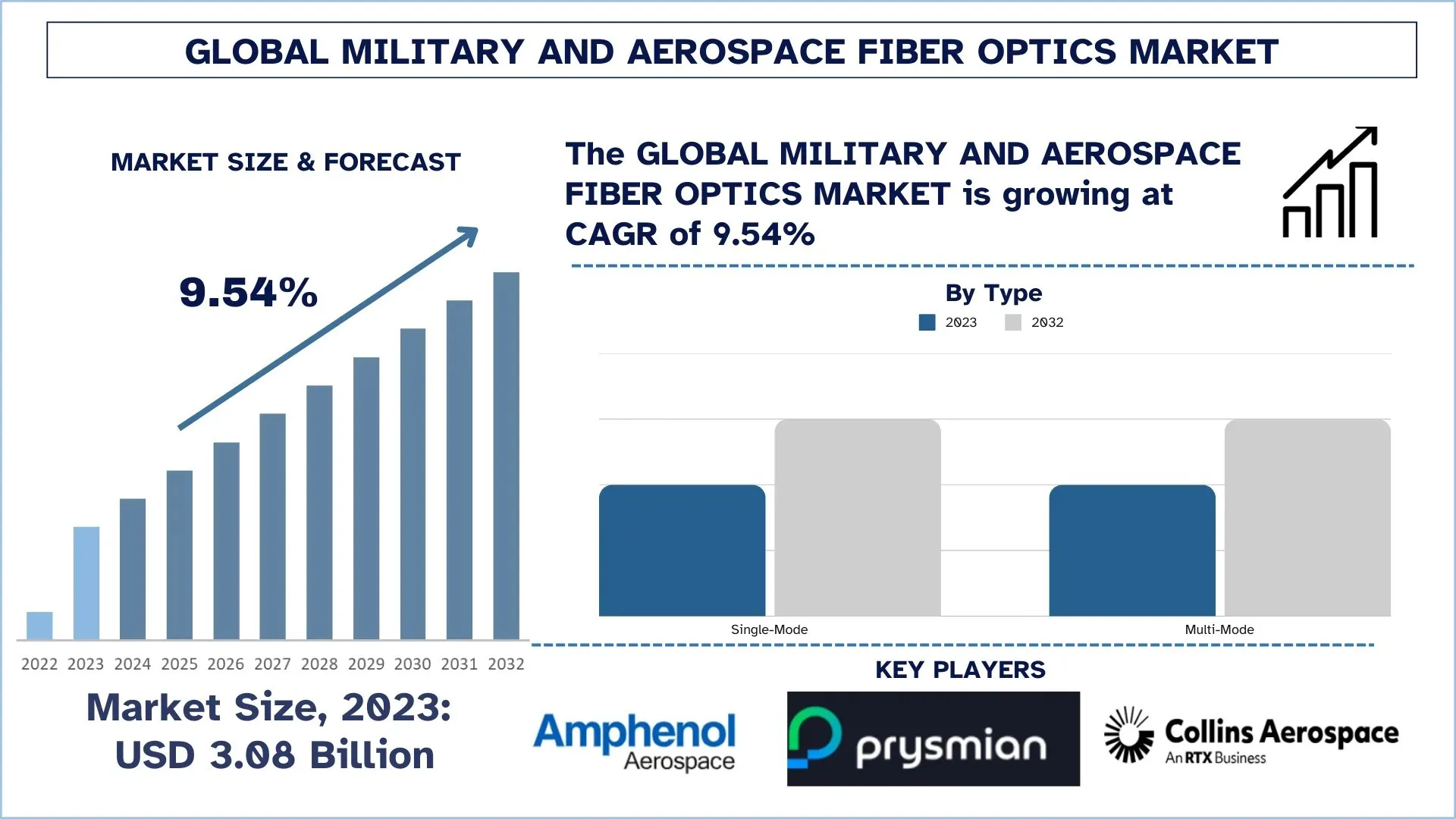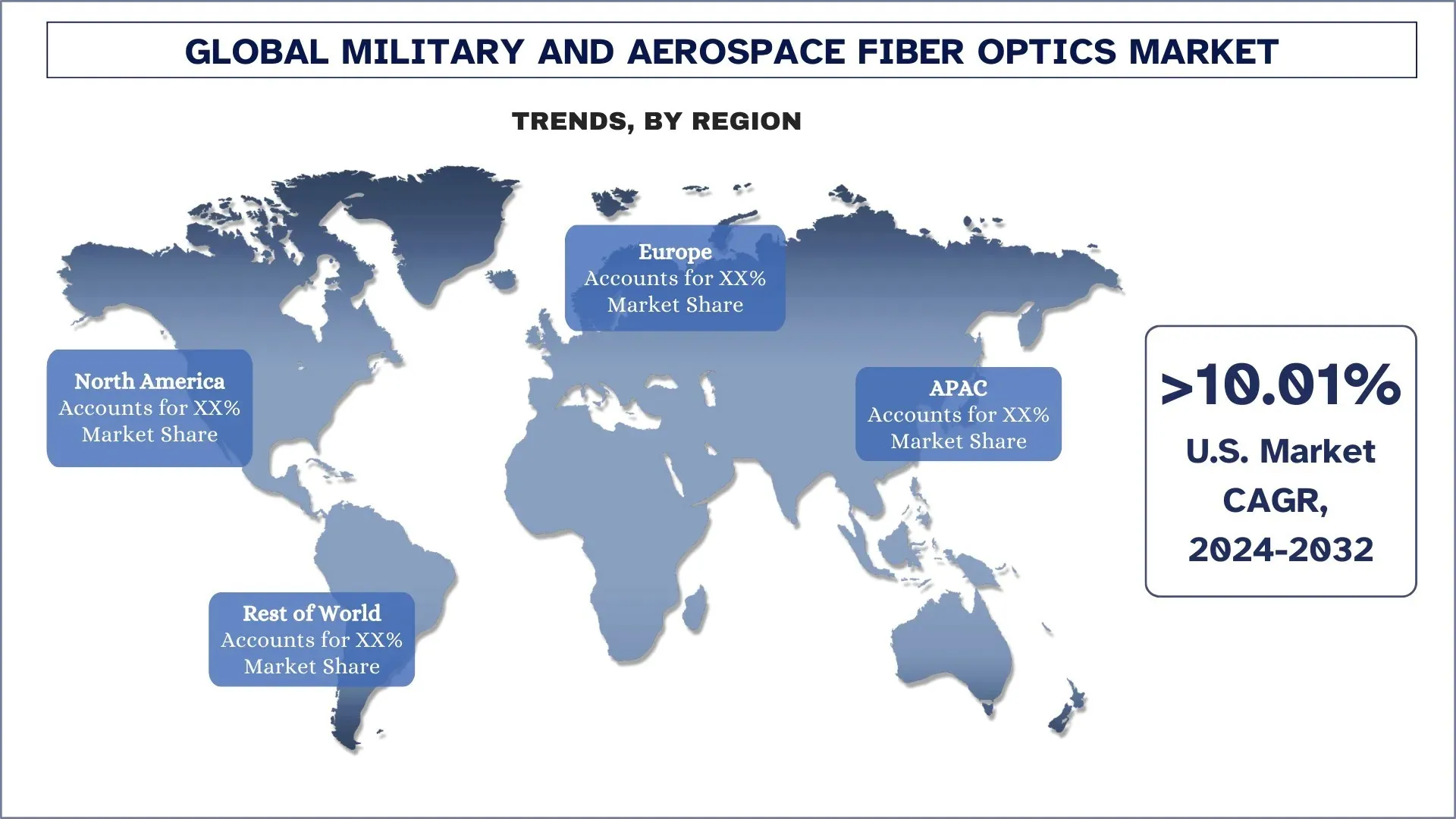- Strona główna
- O nas
- Branża
- Usługi
- Czytanie
- Kontakt
Rynek światłowodów dla wojska i lotnictwa: bieżąca analiza i prognoza (2024-2032)
Nacisk na Typ (Jednomodowe i Wielomodowe); Zastosowanie (Systemy Komunikacyjne, Awionika, Systemy Uzbrojenia, Nadzór i Rozpoznanie, Walka Elektroniczna i Inne); Użytkownik Końcowy (Komercyjny, Wojskowy, Kosmiczny i Inne); oraz Region/Kraj

Wielkość i prognoza rynku światłowodów wojskowych i lotniczych
Wartość rynku światłowodów wojskowych i lotniczych wyniosła w 2023 roku około 3,08 miliarda USD i oczekuje się, że w prognozowanym okresie (2024–2032) będzie rósł w znaczącym tempie CAGR wynoszącym około 9,54% ze względu na zapotrzebowanie na wojnę skoncentrowaną na sieci i rozwój technologii światłowodowej, które napędzają wzrost rynku.
Analiza rynku światłowodów wojskowych i lotniczych
W sektorze obronnym i lotniczym termin „wojskowe produkty i technologie światłowodowe” odnosi się do zaawansowanej technologii światłowodowej wykorzystywanej do szybkiej transmisji danych, komunikacji, wykrywania i nawigacji w obronie i lotnictwie. Wysoka prędkość, niskie opóźnienia, odporność na zakłócenia elektromagnetyczne i niewielka waga składają się na poprawę wydajności przypisywaną tym systemom, co czyni je krytycznymi zastosowaniami w samolotach, satelitach, pociskach i systemach komunikacji na polu bitwy. Wzrost budżetów obronnych, modernizacja infrastruktury wojskowej i pojawienie się systemów bezzałogowych napędzają rynek. Wojna skoncentrowana na sieci i zapotrzebowanie na transmisję danych w czasie rzeczywistym w operacjach teatralnych to niektóre z czynników przyczyniających się do popytu. Ponadto domena lotnicza coraz częściej wykorzystuje światłowody w swoich przyszłych samolotach i satelitach w celu zwiększenia wydajności i zmniejszenia masy, spełniając jednocześnie cele zrównoważonego rozwoju. Oczekuje się, że postęp w technologii światłowodowej, takiej jak włókna wielordzeniowe i fotoniczne układy scalone, wraz ze zwiększonymi inwestycjami w eksplorację kosmosu i programy modernizacji obrony na całym świecie, dodatkowo rozszerzą globalny rynek do 2032 roku. To wyraźnie pokazuje, że światłowody będą w coraz większym stopniu środkiem zaspokajania przyszłych wymagań w zastosowaniach wojskowych i lotniczych.
Trendy na rynku światłowodów wojskowych i lotniczych
W tej sekcji omówiono kluczowe trendy rynkowe wpływające na różne segmenty rynku światłowodów wojskowych i lotniczych, zidentyfikowane przez naszych ekspertów ds. badań.
Integracja fotonicznych układów scalonych (PIC)
Rozwój fotonicznych układów scalonych to zmiana paradygmatu w światłowodach, polegająca na miniaturyzacji komponentów optycznych i poprawie poziomu wydajności. Układy PIC znajdują również zastosowanie w komunikacji wojskowej i awionice, a także na platformach walki elektronicznej, zapewniając wysokie szybkości transmisji danych, mniejsze zużycie energii i zwiększoną niezawodność.
Na przykład taktyczny system zagłuszania AN/ALQ-99 używany przez Marynarkę Wojenną Stanów Zjednoczonych został wyposażony w moduły światłowodowe oparte na układach PIC, które zostały ulepszone, aby stać się bardziej zaawansowanymi w swoich możliwościach walki elektronicznej, zapewniając bezpieczną i wolną od zakłóceń komunikację.
Segmentacja branży światłowodów wojskowych i lotniczych
W tej sekcji przedstawiono analizę kluczowych trendów w każdym segmencie globalnego raportu na temat rynku światłowodów wojskowych i lotniczych, wraz z prognozami na poziomie globalnym, regionalnym i krajowym na lata 2024–2032.
Rynek światłowodów jednomodowych dominuje na rynku światłowodów wojskowych i lotniczych
Na podstawie rodzaju rynek światłowodów wojskowych i lotniczych jest podzielony na jednomodowe i wielomodowe. W 2023 roku dominował rynek światłowodów jednomodowych i oczekuje się, że utrzyma swoją wiodącą pozycję przez cały okres prognozowania. Ze względu na doskonałą wydajność w telekomunikacji dalekiego zasięgu, możliwości przepustowości i tłumienie siły sygnału, światłowody jednomodowe są preferowane w stosunku do włókien wielomodowych. Cechy preferowane w zastosowaniach wojskowych i lotniczych, gdzie ważna jest niezawodność, precyzja i transmisja danych na duże odległości. Włókna jednomodowe są preferowane ze względu na ich zdolność do przesyłania danych na duże odległości przy minimalnej utracie sygnału. Dlatego są one najbardziej odpowiednie do krytycznych zastosowań wojskowych i lotniczych, gdzie niezawodność i wydajność komunikacji są najważniejsze. Włókna jednomodowe są zbudowane z małym rdzeniem, który zapewnia miejsce tylko dla jednego trybu światła, aby przez niego przechodził, co znacznie minimalizuje prawdopodobieństwo degradacji danych podczas transmisji na duże odległości w porównaniu z włóknami wielomodowymi. Włókna jednomodowe są dodatkowo preferowane ze względu na rosnące zapotrzebowanie na komunikację o dużej przepustowości i dużym zasięgu w operacjach wojskowych i lotniczych. Włókna te umożliwiają szybki transfer danych niezbędny do zaawansowanych zastosowań, takich jak nadzór, systemy radarowe i bezpieczne linie komunikacyjne stosowane w operacjach wojskowych. Włókna jednomodowe stają się również ekonomicznym rozwiązaniem dla dużych sieci ze względu na ich cechę niskiej utraty sygnału na dużych odległościach.
Segment systemów komunikacyjnych dominuje na rynku światłowodów wojskowych i lotniczych
Na podstawie zastosowania rynek światłowodów wojskowych i lotniczych jest podzielony na systemy komunikacyjne, awionikę, systemy uzbrojenia, nadzór i rozpoznanie, walkę elektroniczną i inne. Segment systemów komunikacyjnych nadal dominuje na rynku światłowodów wojskowych i lotniczych ze względu na jego krytyczną rolę w zapewnianiu bezpiecznej, szybkiej i niezawodnej transmisji danych w nowoczesnych platformach obronnych i lotniczych. Zwiększone poleganie na tych bezzałogowych systemach, w tym dronach i UAV, wraz z rosnącą tendencją do wojny skoncentrowanej na sieci, spowodowało wzrost zapotrzebowania na systemy komunikacji światłowodowej nowej generacji. Kręgosłup, na przykład, opiera się na światłowodach w celu posiadania infrastruktury komunikacyjnej w myśliwcu F-35 Lightning II, który przekazuje ciągłą wymianę łącza danych między pokładowymi systemami awioniki, czujnikami i centrami dowodzenia. W ten sam sposób, w satelitarnych systemach komunikacyjnych, światłowody zapewniają dużą przepustowość i niski poziom opóźnień w przesyłaniu danych potrzebny do prowadzenia operacji wojskowych i zbierania informacji na skalę światową. Przyjęcie światłowodów jest również wspierane przez rozwój walki elektronicznej (EW), która wymaga bezpiecznych sieci komunikacyjnych w spornych środowiskach. W przeciwieństwie do konwencjonalnych kabli miedzianych, światłowody oferują środek komunikacji, który jest praktycznie nie do przechwycenia i odporny na zagłuszanie, co czyni je dobrym kandydatem do zapewnienia bezpiecznej komunikacji wojskowej. Dokonano dużych inwestycji w rozwój sieci światłowodowych przez Departament Obrony Stanów Zjednoczonych w celu zwiększenia odporności i bezpieczeństwa globalnej infrastruktury komunikacyjnej.

Ameryka Północna zdominowała globalny rynek światłowodów wojskowych i lotniczych
Region Ameryki Północnej pozostaje największym rynkiem światłowodów wojskowych i lotniczych ze względu na kilka czynników, takich jak zaawansowany przemysł obronny, znaczny budżet wojskowy i rosnące przyjęcie autonomicznego uzbrojenia. Technologia światłowodowa ma nieodłączne zalety w sektorze obronnym ze względu na dobrze ugruntowaną infrastrukturę technologiczną i ciągłe innowacje utrzymywane w Ameryce Północnej. Niektórzy z największych producentów obronnych na świecie, Lockheed Martin, Raytheon i Northrop Grumman, inwestują w światłowody, integrując je ze swoimi programami wojskowymi i lotniczymi. Firmy te polegają na światłowodach w zastosowaniach takich jak szybka transmisja danych, bezpieczna komunikacja i systemy monitoringu w czasie rzeczywistym o dużym znaczeniu. Dodatkowo, technologie nowej generacji w sektorze obronnym, takie jak broń hipersoniczna, zaawansowane myśliwce i systemy cyberobrony, z których wszystkie są zależne od światłowodów, które wspierają wzmocnienie – niskie straty sygnału i odporność na zakłócenia elektromagnetyczne, zapewniając w ten sposób ważną komunikację wewnątrz, która jest bezpieczna i charakteryzuje się wysoką wydajnością. Ta komunikacja jest wymagana do tworzenia i utrzymywania efektywności operacyjnej w nowoczesnej wojnie. Rosnące zapotrzebowanie na światłowody ze względu na zbliżające się rozpowszechnianie autonomicznych systemów uzbrojenia i UAV jako część operacji wojskowych dodatkowo napędza wzrost rynku. Ponadto ciągłe tworzenie infrastruktury 5G i komunikacyjnej w środowiskach wojskowych oraz przyjęcie światłowodów wspierane przez ważną, przyspieszoną drogę transmisji danych z cechami bezpieczeństwa, które mają również zastosowanie w lotnictwie cywilnym, zabezpieczyło pozytywny wzrost rynku.

Konkurencyjny krajobraz branży światłowodów wojskowych i lotniczych
Rynek światłowodów wojskowych i lotniczych jest konkurencyjny, z kilkoma globalnymi i międzynarodowymi graczami. Kluczowi gracze przyjmują różne strategie wzrostu, aby zwiększyć swoją obecność na rynku, takie jak partnerstwa, umowy, współpraca, ekspansje geograficzne oraz fuzje i przejęcia.
Najwięksi producenci światłowodów wojskowych i lotniczych
Niektórzy z głównych graczy działających na rynku to Amphenol Aerospace, Prysmian Group, Collins Aerospace, AFL, Nexans, Optical Cable Corporation, W. L. Gore & Associates, Inc., Corning Incorporated, TE Connectivity i Timbercon, Inc.
Najnowsze wydarzenia na rynku światłowodów wojskowych i lotniczych
- W marcu 2024 r. – AFL ogłosiła wielomilionowe inwestycje, przekraczające 50 milionów USD, w celu rozszerzenia swojej działalności w zakresie produkcji kabli światłowodowych w Południowej Karolinie. Oczekuje się, że taka inicjatywa będzie finansowana w ramach ustawy rządu USA o inwestycjach w infrastrukturę i zatrudnienie oraz programów „Internet dla wszystkich”, aby zapewnić dostęp do szerokopasmowego Internetu w każdym zakątku kraju. Oczekuje się, że to rozszerzenie stworzy wiele nowych miejsc pracy, pobudzi lokalne gospodarki i zapewni zgodność produktów AFL z ustawą „Build America, Buy America Act” (BABA). Inwestycja ta jest uzupełnieniem wcześniejszego zobowiązania AFL do zainwestowania ponad 35 milionów USD w produkcję kabli w Stanach Zjednoczonych. Taka inwestycja koncentruje się na promowaniu wdrażania szerokopasmowego Internetu i modernizacji sieci energetycznych.
- W styczniu 2023 r. – AFL, czołowy producent kabli światłowodowych i sprzętu do spawania światłowodów, zaprezentował nową generację sprzętu do spawania światłowodów i przygotowania włókien podczas niedawno zakończonych wystaw SPIE BiOS i Photonics West. Nowa linia obejmuje zaawansowane urządzenia do powlekania i łuparki, a także inne urządzenia zaprojektowane w celu zwiększenia przygotowania i ochrony włókien do spawania. Ta nowa linia produktów została opracowana w celu zaspokojenia wysoce technicznych potrzeb specjalistycznych włókien optycznych. Oczekuje się, że tak wydajne narzędzia poprawią niezawodność i powtarzalność, a tym samym zapewnią użytkownikom większą pewność w operacjach światłowodowych.
- W kwietniu 2023 r. – SEDI-ATI, jeden z głównych producentów światłowodów dla sektora wojskowego i lotniczego, wprowadził na rynek światłowód do optopirotechnicznych pociągów, od sprzęgania lasera z włóknem optycznym po sprawdzanie integralności linii.
Zakres raportu dotyczącego rynku światłowodów wojskowych i lotniczych
Atrybut raportu | Szczegóły |
Rok bazowy | 2023 |
Okres prognozowania | 2024–2032 |
Dynamika wzrostu | Przyspieszenie przy CAGR wynoszącym 9,54% |
Wielkość rynku w 2023 r. | 3,08 miliarda USD |
Analiza regionalna | Ameryka Północna, Europa, Azja i Pacyfik, Reszta świata |
Główny region wnoszący wkład | Oczekuje się, że region Azji i Pacyfiku będzie rósł w najwyższym tempie CAGR w prognozowanym okresie. |
Kluczowe objęte kraje | USA, Kanada, Niemcy, Francja, Wielka Brytania, Hiszpania, Włochy, Chiny, Japonia i Indie |
Amphenol Aerospace, Prysmian Group, Collins Aerospace, AFL, Nexans, Optical Cable Corporation, W. L. Gore & Associates, Inc., Corning Incorporated, TE Connectivity i Timbercon, Inc. | |
Zakres raportu | Trendy rynkowe, czynniki napędzające i ograniczenia; Szacowanie i prognozowanie przychodów; Analiza segmentacji; Analiza popytu i podaży; Konkurencyjny krajobraz; Profilowanie firm |
Spis treści
Metodologia Badań Rynku Światłowodów dla Wojska i Przemysłu Lotniczego i Kosmicznego (2022-2032)
Przeanalizowaliśmy historyczny rynek, oszacowaliśmy obecny rynek i prognozowaliśmy przyszły rynek globalnego rynku światłowodów dla wojska i przemysłu lotniczego i kosmicznego, aby ocenić jego zastosowanie w głównych regionach na całym świecie. Przeprowadziliśmy wyczerpujące badania wtórne, aby zebrać historyczne dane rynkowe i oszacować obecną wielkość rynku. Aby zweryfikować te spostrzeżenia, dokładnie przeanalizowaliśmy liczne ustalenia i założenia. Dodatkowo przeprowadziliśmy dogłębne wywiady pierwotne z ekspertami branżowymi w całym łańcuchu wartości światłowodów dla wojska i przemysłu lotniczego i kosmicznego. Po zatwierdzeniu danych rynkowych za pomocą tych wywiadów, użyliśmy podejścia zarówno odgórnego, jak i oddolnego, aby prognozować całkowitą wielkość rynku. Następnie zastosowaliśmy metody podziału rynku i triangulacji danych, aby oszacować i przeanalizować wielkość rynku segmentów i podsegmentów branży.
Inżynieria Rynku
Zastosowaliśmy technikę triangulacji danych, aby sfinalizować ogólne oszacowanie rynku i wyprowadzić precyzyjne dane statystyczne dla każdego segmentu i podsegmentu globalnego rynku światłowodów dla wojska i przemysłu lotniczego i kosmicznego. Podzieliliśmy dane na kilka segmentów i podsegmentów, analizując różne parametry i trendy, w tym typ, zastosowanie, użytkownika końcowego i regiony w ramach globalnego rynku światłowodów dla wojska i przemysłu lotniczego i kosmicznego.
Główny cel badania Globalnego Rynku Światłowodów dla Wojska i Przemysłu Lotniczego i Kosmicznego
Badanie identyfikuje obecne i przyszłe trendy na globalnym rynku światłowodów dla wojska i przemysłu lotniczego i kosmicznego, zapewniając strategiczne spostrzeżenia dla inwestorów. Podkreśla atrakcyjność rynku regionalnego, umożliwiając uczestnikom branży wykorzystanie niewykorzystanych rynków i uzyskanie przewagi pioniera. Inne cele ilościowe badań obejmują:
Analiza Wielkości Rynku: Ocena obecnej i prognozowanej wielkości rynku globalnego rynku światłowodów dla wojska i przemysłu lotniczego i kosmicznego oraz jego segmentów pod względem wartości (USD).
Segmentacja Rynku Światłowodów dla Wojska i Przemysłu Lotniczego i Kosmicznego: Segmenty w badaniu obejmują obszary typu, zastosowania, użytkowników końcowych i regionów.
Ramy Regulacyjne i Analiza Łańcucha Wartości: Zbadanie ram regulacyjnych, łańcucha wartości, zachowań klientów i krajobrazu konkurencyjnego branży światłowodów dla wojska i przemysłu lotniczego i kosmicznego.
Analiza Regionalna: Przeprowadzenie szczegółowej analizy regionalnej dla kluczowych obszarów, takich jak Azja i Pacyfik, Europa, Ameryka Północna i Reszta Świata.
Profile Firm i Strategie Rozwoju: Profile firm działających na rynku światłowodów dla wojska i przemysłu lotniczego i kosmicznego oraz strategie rozwoju przyjęte przez uczestników rynku w celu utrzymania szybko rozwijającego się rynku.
Najczęściej zadawane pytania FAQ
P1: Jaka jest obecna wielkość i potencjał wzrostu rynku światłowodów dla wojska i lotnictwa?
Wartość rynku światłowodów dla wojska i lotnictwa osiągnęła 3,08 miliarda USD w 2023 roku i oczekuje się, że w okresie prognozy (2024-2032) będzie rósł w tempie CAGR wynoszącym 3,5%.
Pytanie 2: Jakie czynniki napędzają wzrost rynku światłowodów dla wojska i lotnictwa?
Głównymi czynnikami napędzającymi rynek światłowodów dla wojska i lotnictwa są rosnące zapotrzebowanie na wojnę sieciocentryczną oraz postęp w technologii światłowodowej, które napędzają wzrost rynku.
Pytanie 3: W kategorii typów, który segment ma największy udział w rynku światłowodów dla wojska i lotnictwa?
Rynek światłowodów jednomodowych ma największy udział w rynku światłowodów wojskowych i lotniczych.
P4: Jakie są główne trendy na rynku światłowodów dla wojska i lotnictwa?
Integracja fotonicznych układów scalonych (PIC) i zastosowanie światłowodów wielordzeniowych to główne trendy na rynku światłowodów dla wojska i przemysłu lotniczego i kosmicznego.
P5: Który region zdominuje rynek światłowodów dla wojska i lotnictwa?
Region Ameryki Północnej zdominował rynek w 2023 roku.
Powiązane Raporty
Klienci, którzy kupili ten przedmiot, kupili również










